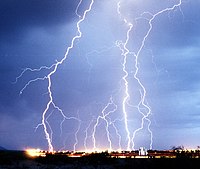
Photo from wikipedia
Solids facing a plasma are a common situation in many astrophysical systems and laboratory setups. Moreover, many plasma technology applications rely on the control of the plasma-surface interaction, i.e., of… Click to show full abstract
Solids facing a plasma are a common situation in many astrophysical systems and laboratory setups. Moreover, many plasma technology applications rely on the control of the plasma-surface interaction, i.e., of the particle, momentum and energy fluxes across the plasma-solid interface. However, presently often a fundamental understanding of them is missing, so most technological applications are being developed via trial and error. The reason is that the physical processes at the interface of a low-temperature plasma and a solid are extremely complex, involving a large number of elementary processes in the plasma, in the solid as well as fluxes across the interface. An accurate theoretical treatment of these processes is very difficult due to the vastly different system properties on both sides of the interface: Quantum versus classical behavior of electrons in the solid and plasma, respectively; as well as the dramatically differing electron densities, length and time scales. Moreover, often the system is far from equilibrium. In the majority of plasma simulations surface processes are either neglected or treated via phenomenological parameters such as sticking coefficients, sputter rates or secondary electron emission coefficients. However, those parameters are known only in some cases and with very limited accuracy. Similarly, while surface physics simulations have often studied the impact of single ions or neutrals, so far, the influence of a plasma medium and correlations between successive impacts have not been taken into account. Such an approach, necessarily neglects the mutual influences between plasma and solid surface and cannot have predictive power.In this paper we discuss in some detail the physical processes of the plasma-solid interface which brings us to the necessity of coupled plasma-solid simulations. We briefly summarize relevant theoretical methods from solid state and surface physics that are suitable to contribute to such an approach and identify four methods. The first are mesoscopic simulations such as kinetic Monte Carlo and molecular dynamics that are able to treat complex processes on large scales but neglect electronic effects. The second are quantum kinetic methods based on the quantum Boltzmann equation that give access to a more accurate treatment of surface processes using simplifying models for the solid. The third approach are ab initio simulations of surface process that are based on density functional theory (DFT) and time-dependent DFT. The fourths are nonequilibrium Green functions that able to treat correlation effects in the material and at the interface. The price for the increased quality is a dramatic increase of computational effort and a restriction to short time and length scales. We conclude that, presently, none of the four methods is capable of providing a complete picture of the processes at the interface. Instead, each of them provides complementary information, and we discuss possible combinations.
Journal Title: Frontiers of Chemical Science and Engineering
Year Published: 2019
Link to full text (if available)
Share on Social Media: Sign Up to like & get
recommendations!